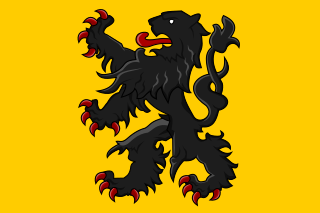
Year 1115 (MCXV) was a common year starting on Friday of the Julian calendar.
Baldwin VI, also known as Baldwin the Good, was the count of Hainaut from 1051 to 1070 and count of Flanders from 1067 to 1070.

Robert II, Count of Flanders was Count of Flanders from 1093 to 1111. He became known as Robert of Jerusalem or Robert the Crusader after his exploits in the First Crusade.

Amandus, commonly called Saint Amand, was a bishop of Tongeren-Maastricht and one of the catholic missionaries of Flanders. He is venerated as a saint, particularly in France and Belgium.

The Tironensian Order or the Order of Tiron was a medieval monastic order named after the location of the mother abbey in the woods of Thiron-Gardais in Perche, some 35 miles west of Chartres in France). They were popularly called "Grey Monks" because of their grey robes, which their spiritual cousins, the monks of Savigny, also wore.

The Archdiocese of Cambrai is a Latin Church ecclesiastical jurisdiction or archdiocese of the Catholic Church in France, comprising the arrondissements of Avesnes-sur-Helpe, Cambrai, Douai, and Valenciennes within the département of Nord, in the region of Nord-Pas-de-Calais. The current archbishop is Vincent Dollmann, appointed in August 2018. Since 2008 the archdiocese has been a suffragan of the Archdiocese of Lille.
Carloman was the youngest son of Charles the Bald, king of West Francia, and his first wife, Ermentrude. He was intended for an ecclesiastical career from an early age, but in 870 rebelled against his father and tried to claim a part of the kingdom as an inheritance.

The Abbey of St Vaast was a Benedictine monastery situated in Arras, département of Pas-de-Calais, France.

Lobbes Abbey was a Benedictine monastery in the municipality of Lobbes, Hainaut, Belgium. The abbey played an important role in the religious, political and religious life of the Prince-Bishopric of Liège, especially around the year 1000. The abbey's founding saint is Saint Landelin; four other saints are also connected with the abbey.

Saint Godelieve is a Flemish saint. She behaved with charity and gentleness to all, accepting an arranged marriage as was the custom, but her husband and family turned out to be abusive. Eventually he had her strangled by his servants.

The Abbey of Saint Bertin was a Benedictine monastic abbey in Saint-Omer, France. The buildings are now in ruins, which are open to the public. It was initially dedicated to Saint Peter but was rededicated to its second abbot, Saint Bertin. The abbey is known for its Latin cartulary whose first part is attributed to Folcwin.

Anchin Abbey was a Benedictine monastery founded in 1079 in the commune of Pecquencourt in what is now the Nord department of France.
Gerard of Florennes, bishop of Cambrai as Gerard I, had formerly been chaplain to Henry II, Holy Roman Emperor, and helpful to the latter in his political negotiations with Robert the Pious, King of France. In 1024 Gerard called a synod in Arras to confront a purported heresy fomented by the Gundulfian heretics, who denied the efficacy of the Eucharist. The records of this synod, the Acta Synodi Atrebatensis, preserve a summary of orthodox Christian doctrine of the early eleventh century, as well contemporary peace-making practices. According to this text's author, the heretics were convinced by Gerard's explanation of orthodoxy, renounced their heresy, and were reconciled with the church.

Marchiennes Abbey was a French monastery located on the Scarpe in Marchiennes. It was founded around 630 by Adalbard of Douai, and Irish monks, disciples of Saint Columbanus, on the advice of Saint Amand. One of its founders was Rictrude, who made it double monastery in 643. In around 1024 it became monastery of men again and adopted the Benedictine rule. On the birth of the town of Marchiennes the abbey became its economic motor until being suppressed in 1791 during the French Revolution. In 1814 all but its 1748 gatehouse was demolished. Its remains were inscribed on the inventory of monuments historiques on 17 May 1974,
Folcard or Foulcard was a Flemish hagiographer.

The County of Flanders was one of the most powerful political entities in the medieval Low Countries, located on the North Sea coast of modern-day Belgium and north-eastern France. Unlike the neighbouring states of Brabant and Hainaut, it was within the territory of the Kingdom of France. The counts of Flanders held the most northerly part of the kingdom, and were among the original twelve peers of France. For centuries, the economic activity of the Flemish cities, such as Ghent, Bruges and Ypres, made Flanders one of the most affluent regions in Europe, and also gave them strong international connections to trading partners.

Ename Abbey (1063–1795) was a Benedictine monastery in the village of Ename, now a suburb of Oudenaarde, East Flanders, Belgium. It was founded by Adele of France, wife of Baldwin V, Count of Flanders, and was confiscated during the French Revolutionary Wars. It was then sold and dismantled.

The Saint-Martin Abbey in the historic center of Tournai, in the Wallonia region of Belgium is a former Benedictine abbey, dating back to the 7th century. It was re-established in the late 11th century by Odo of Tournai and it immediately became an important Benedictine settlement. A fire devastated the abbey in 1340 in the Siege of Tournai during the Hundred Years' War. It was later rebuilt by renowned architect Laurent-Benoît Dewez in the 1760s. The abbey was dissolved during the French Revolution in 1796 and the buildings were largely demolished except for the abbot's palace, which today serves as the town hall.

The Abbey of Saint Winnoc is a former monastery in Bergues, in the department of Nord in northern France. It traces its origins to the 7th century, and from the early 11th century became a Benedictine abbey and grew in wealth. The monastery was damaged by fire twice, and heavily rebuilt in the 18th century. Following the French Revolution, the abbey was disbanded, sold and most of the buildings dismantled. Only the former gate and two towers remain, as they were used as navigational aids.
Baldwin I of Guînes,, was the count of Guînes. He fought at the battle of Cassel (1071) for Robert I, Count of Flanders. Later, Baldwin and Enguerrand of Lillers went on pilgrimage to Santiago de Compostela. He founded Andres Abbey and was later buried there in 1090.















